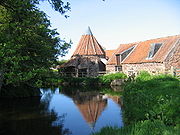
Preston Mill
Encyclopedia

Watermill
A watermill is a structure that uses a water wheel or turbine to drive a mechanical process such as flour, lumber or textile production, or metal shaping .- History :...
on the River Tyne
River Tyne, Scotland
The River Tyne is a river in Scotland, UK. It rises in the Moorfoot Hills in Midlothian near Tynehead to the south of Edinburgh, at the junction of the B6458 and the B6367. It continues for approx...
at the eastern edge of East Linton
East Linton
East Linton is a town in East Lothian, Scotland, situated on the River Tyne and A199 road five miles east of Haddington, with a population of 1,774...
on the B1407 Preston Road, in East Lothian
East Lothian
East Lothian is one of the 32 council areas of Scotland, and a lieutenancy Area. It borders the City of Edinburgh, Scottish Borders and Midlothian. Its administrative centre is Haddington, although its largest town is Musselburgh....
, Scotland
Scotland
Scotland is a country that is part of the United Kingdom. Occupying the northern third of the island of Great Britain, it shares a border with England to the south and is bounded by the North Sea to the east, the Atlantic Ocean to the north and west, and the North Channel and Irish Sea to the...
, UK. It is situated close to Prestonkirk Parish Church
Prestonkirk Parish Church
Prestonkirk Parish Church is a Church of Scotland parish church at East Linton, in the parish of Traprain, East Lothian, Scotland, UK, close to Preston Mill, Smeaton, Phantassie, and the River Tyne.-Building:...
, the Smeaton
Smeaton, East Lothian
Smeaton is a village and country estate in East Lothian, Scotland. It is off the B1407, near East Linton, and very close to Prestonkirk Parish Church as well as the National Trust for Scotland properties Preston Mill and Phantassie Doocot.-The Estate:...
Hepburn Estate, Smeaton Lake, and Phantassie Doocot.
There has been a mill on the site since the 16th century. The present mill dates from the 18th century and is in the care of the National Trust for Scotland
National Trust for Scotland
The National Trust for Scotland for Places of Historic Interest or Natural Beauty, commonly known as the National Trust for Scotland describes itself as the conservation charity that protects and promotes Scotland's natural and cultural heritage for present and future generations to...
. It was used commercially until 1959, and it produced oatmeal
Oatmeal
Oatmeal is ground oat groats , or a porridge made from oats . Oatmeal can also be ground oat, steel-cut oats, crushed oats, or rolled oats....
. The River Tyne still drives the water wheel
Water wheel
A water wheel is a machine for converting the energy of free-flowing or falling water into useful forms of power. A water wheel consists of a large wooden or metal wheel, with a number of blades or buckets arranged on the outside rim forming the driving surface...
, and the machinery can still be seen at work by visitors taking part in a tour. There is also an exhibition about milling, and a mill pond
Mill pond
A mill pond is any body of water used as a reservoir for a water-powered mill. Mill ponds were often created through the construction of a mill dam across a waterway. In many places, the common proper name Mill Pond name has remained even though the mill has long since gone...
.
The engineer
Engineer
An engineer is a professional practitioner of engineering, concerned with applying scientific knowledge, mathematics and ingenuity to develop solutions for technical problems. Engineers design materials, structures, machines and systems while considering the limitations imposed by practicality,...
and millwright
Millwright
A millwright is a craftsman or tradesman engaged with the construction and maintenance of machinery.Early millwrights were specialist carpenters who erected machines used in agriculture, food processing and processing lumber and paper...
Andrew Meikle
Andrew Meikle
Andrew Meikle was an early mechanical engineer credited with inventing the threshing machine, a device used to remove the outer husks from grains of wheat. This was regarded as one of the key developments of the British Agricultural Revolution in the late 18th century...
maintained the mill in the 18th century. In 1948 a flood submerged the buildings, and in 1950 a local land owner gave the mill to the National Trust for Scotland
National Trust for Scotland
The National Trust for Scotland for Places of Historic Interest or Natural Beauty, commonly known as the National Trust for Scotland describes itself as the conservation charity that protects and promotes Scotland's natural and cultural heritage for present and future generations to...
.
The milling firm Rank Hovis McDougall provided help with the renovation and expertise to allow the mill to be operative again.
Preston Mill consists of a kiln
Kiln
A kiln is a thermally insulated chamber, or oven, in which a controlled temperature regime is produced. Uses include the hardening, burning or drying of materials...
, a mill, and the miller's house. The mill wheel dates back to 1909. The mill is loved by visitors, painters and photographers, especially the kiln with its conical red pantile
Pantile
Pantile may refer to:*A type of roof tile*The Pantiles, an area of Tunbridge Wells in Kent, England...
roof.
External links
- CANMORE/RCAHMS record for Preston Mill
- RCAHMS record for Preston Mill
- CANMORE/RCAHMS record for Preston Mill, Weir

